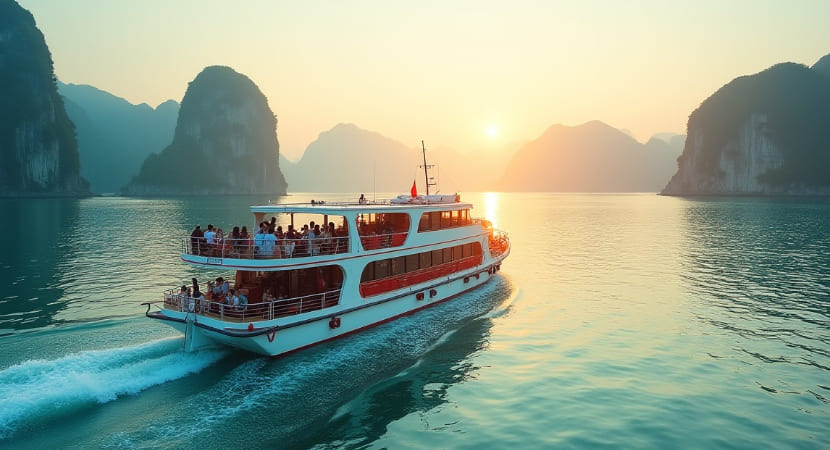Tuesday, July 29, 2025

Water travel has become an increasingly popular mode of transportation in South Asia, with ferries playing a key role in enhancing tourism, regional connectivity and local tourism. The Chimelong Ferry, which launched its inaugural voyage on July 8, 2025, between Hong Kong International Airport and the Hengqin Chimelong International Ocean Resort, is one such example of how ferries are transforming the tourism landscape. This new ferry service is part of a broader movement to improve cross-border travel and facilitate easier access to major tourist attractions in the Guangdong-Hong Kong-Macao Greater Bay Area (GBA).
Ferries: An Essential Mode of Travel in South Asia
Ferries have long been an important part of South Asian travel, providing crucial links between major cities, islands, and tourist destinations. In Hong Kong, the use of ferries is deeply rooted in its history and continues to be an efficient way to navigate the city and its surrounding regions. The Chimelong Ferry is part of this tradition, providing hassle-free access for international travelers heading to the Chimelong Resort in Hengqin. With direct connections from Hong Kong International Airport to key destinations in Guangdong, ferries are now considered a seamless, convenient alternative to traditional land travel.
In addition to the Chimelong Ferry, other ferry services are operating across South Asia, especially in places like India, Sri Lanka, and the Maldives, where water travel remains vital for accessing remote areas and islands. As tourism grows in the region, the demand for efficient, affordable, and scenic ferry services is increasing, positioning ferries as a central part of the travel experience.
The Rise of the Chimelong Ferry: Improving Accessibility
The Chimelong Ferry offers an innovative solution to common travel challenges, such as complicated transfer routes, language barriers, and luggage handling issues that international tourists often face. With the ferry’s one-stop direct access model, travelers can avoid the hassle of multiple transfers between airports, bus stations, and train terminals. Instead, the ferry provides a direct, seamless journey from Hong Kong to Hengqin, making it easier for tourists to visit major attractions like the Chimelong Ocean Resort and the Chimelong Safari Park.
This approach to water travel in the Greater Bay Area reflects a broader regional effort to integrate transportation and tourism infrastructure. By offering easier access to key tourist destinations via ferries, destinations like Hengqin are becoming increasingly accessible for both domestic and international visitors, helping to boost the region’s tourism economy.
Hong Kong’s Role in Regional Water Travel
As a major global hub for tourism and business, Hong Kong has long been a central point for water travel in the region. Ferries from Hong Kong connect the city to several neighboring regions including Macao, Zhuhai, and the islands of the South China Sea. The launch of services like the Chimelong Ferry further cements Hong Kong’s importance as a gateway to mainland China and the Greater Bay Area.
For tourists visiting Hong Kong, ferries offer a scenic and efficient way to explore the city’s bustling harbor, islands, and nearby regions. The iconic Star Ferry, which connects Hong Kong Island and Kowloon, has been a favorite for travelers for over a century, providing stunning views of the skyline and harbor. These ferry services not only enhance the travel experience but also contribute significantly to local tourism, offering a unique perspective of the city and its surrounding regions.
Expanding Ferry Networks in South Asia
In South Asia, countries like India, Sri Lanka, and the Maldives are also expanding their ferry services to enhance regional connectivity and tourism. The Andaman Islands in India and the Maldives are perfect examples of destinations where ferries are an essential part of travel. In these regions, ferries offer both practical transportation options for locals and an attractive activity for tourists.
The Indian government has invested in upgrading ferry terminals and increasing maritime routes to boost tourism to its coastal regions. Sri Lanka has similarly focused on expanding ferry services to attract international tourists seeking a convenient and scenic way to explore the country’s beautiful coastlines and islands.
The Future of Ferries in Regional Tourism
Ferries are set to become even more crucial for regional tourism in South Asia. The success of services like the Chimelong Ferry in China showcases the growing importance of integrating water travel into tourism strategies. As more destinations recognize the benefits of ferry services—such as increased accessibility, environmental sustainability, and a unique travel experience—they will likely invest in further expansion of their own ferry networks.
For tourists, this means more convenient options for traveling between islands, cities, and coastal areas. It also means a more sustainable mode of transport that can help reduce carbon footprints in heavily trafficked regions. As South Asia becomes an even more attractive destination for international tourists, ferries will be key to ensuring easy access to both well-known and off-the-beaten-path locations.
Tips for Tourists Using Ferries in South Asia
For those planning to use ferries while traveling in South Asia, there are a few tips to make the experience more enjoyable:
- Check Schedules: Ferries can have fluctuating schedules based on weather conditions and seasonality. Always check the schedule in advance to avoid long waiting times or missed connections.
- Book in Advance: During peak tourist seasons, ferry services can get busy. Booking your tickets in advance, either online or through local operators, can help ensure you get a seat.
- Pack Smart: Some ferries have limited luggage space, so pack light and make sure your luggage is manageable. Keep essential items like sunscreen and water in a small carry-on bag.
- Plan for the Weather: Ferries are often subject to weather conditions. In tropical regions, like Sri Lanka and the Maldives, be prepared for sudden rains or strong winds. Bring appropriate clothing and check weather forecasts before you travel.
- Enjoy the Views: Many ferry rides in South Asia offer breathtaking views of coastlines, islands, and historical landmarks. Don’t forget to take in the scenery and enjoy the unique experience that water travel offers.
Conclusion: Ferries Shaping South Asia’s Travel Future
The rise of ferries in South Asia is exemplified by services like the Chimelong Ferry and is reshaping how tourists and locals alike experience travel across the region. With increased convenience, accessibility, and scenic routes, ferries provide a compelling alternative to traditional transportation, with beautiful views of the sea. As more countries invest in expanding water travel networks, ferries will become an even more integral part of the tourism industry offering a sustainable, enjoyable, and efficient way to explore the wonders of South Asia.








